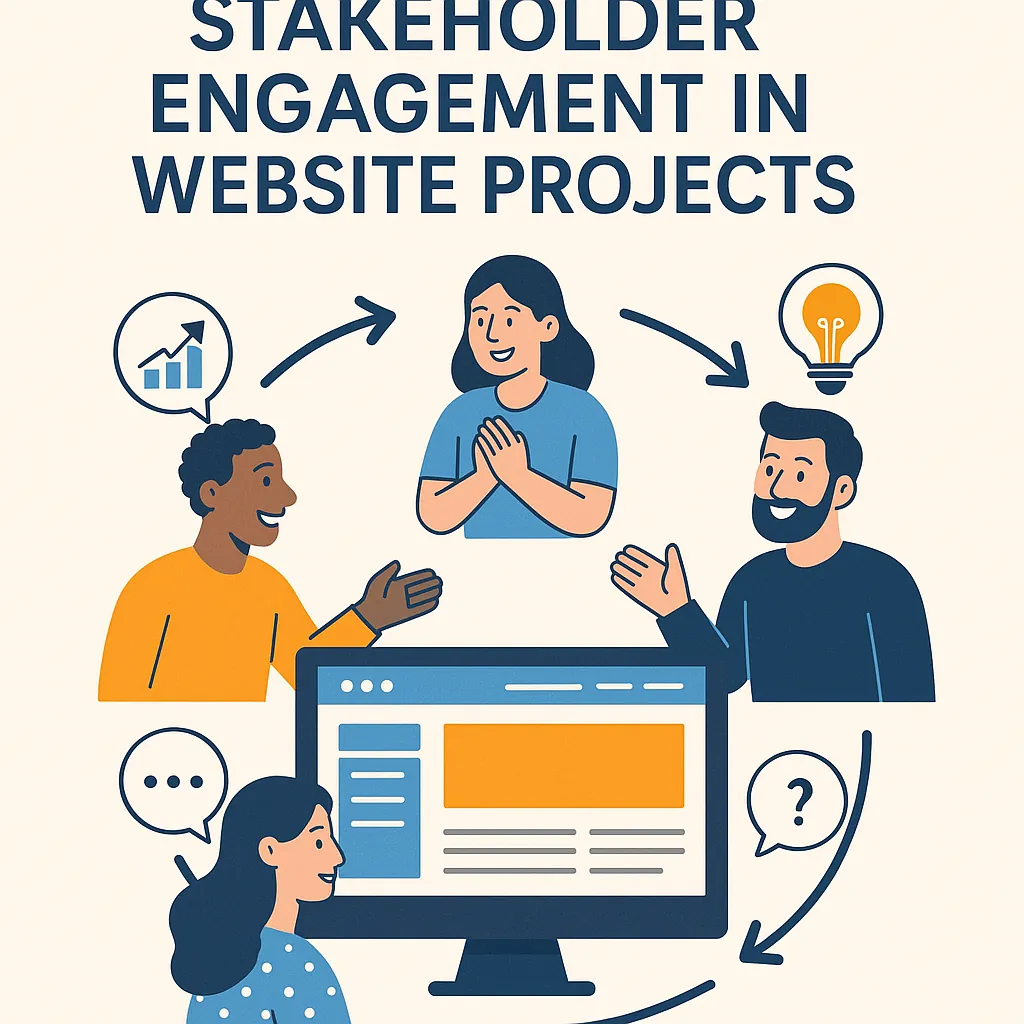Introduction
Stakeholder engagement plays a pivotal role in ensuring the success of any project. Stakeholders can include anyone from clients and end-users to team members and external partners, each bringing unique perspectives and requirements that can significantly influence the project’s outcome. Engaging these stakeholders effectively throughout the project lifecycle is not just beneficial; it is essential for aligning project goals with stakeholder expectations and achieving desired results.
Defining Stakeholder Engagement
Stakeholder engagement refers to the process of involving all parties who have a vested interest in the project. This includes identifying stakeholders, understanding their needs and concerns, and maintaining open lines of communication throughout the project. In the context of website projects, this engagement is crucial as it helps to ensure that the final product meets the functional and aesthetic requirements of its users while also adhering to the strategic objectives of the organization.
The Critical Nature of Stakeholder Engagement
The importance of stakeholder engagement cannot be overstated. Projects that prioritize stakeholder involvement tend to experience:
- Improved Communication: Regular interaction fosters transparency and trust, reducing the likelihood of misunderstandings and conflicts.
- Enhanced User Satisfaction: By incorporating feedback from end-users, project teams can create a website that truly meets user needs, leading to higher satisfaction and engagement levels.
- Increased Project Buy-in: When stakeholders feel heard and valued, they are more likely to support the project, which can lead to smoother implementation and adoption phases.
- Risk Mitigation: Engaging stakeholders early and often allows project managers to identify potential risks and address them proactively, minimizing disruptions later in the project.
Main Strategies for Engaging Stakeholders
In this blog post, we will explore several effective strategies for engaging stakeholders throughout the website project lifecycle. These strategies include:
- Regular Communication: Establishing a consistent communication plan that includes updates, feedback sessions, and collaborative tools.
- Stakeholder Mapping: Identifying and categorizing stakeholders based on their influence and interest levels to tailor engagement efforts accordingly.
- Workshops and Feedback Sessions: Organizing interactive sessions to gather insights and foster collaboration among stakeholders.
- Iterative Development: Utilizing agile methodologies to incorporate stakeholder feedback at various stages of the project, ensuring that the final product aligns with their expectations.
By implementing these strategies, project managers and business analysts can enhance stakeholder engagement, ultimately leading to more successful website projects.
Understanding Stakeholders in Website Projects
Stakeholder engagement is crucial for the success of any project. Stakeholders are individuals or groups that have an interest in the outcome of a project, and their involvement can significantly influence the direction and success of the project. Here, we will define stakeholders, differentiate between internal and external stakeholders, and identify common stakeholders involved in website projects.
Defining Stakeholders and Their Roles
Stakeholders in website projects can be defined as anyone who has a vested interest in the project’s outcome. This includes individuals or groups who can affect or be affected by the project. Their roles can vary widely, from providing input and feedback to making critical decisions that shape the project. Understanding who these stakeholders are and what they need is essential for effective project management.
Roles of Stakeholders:
- Decision-Makers: These are typically senior management or project sponsors who have the authority to approve budgets and project scopes.
- Advisors: Individuals who provide expertise and guidance, such as technical advisors or consultants.
- Users: End-users who will interact with the website and whose needs must be prioritized to ensure usability and satisfaction.
Differentiating Between Internal and External Stakeholders
Stakeholders can be categorized into two main groups: internal and external.
- Internal Stakeholders: These are individuals or groups within the organization. They include:
- Project Managers: Responsible for overseeing the project and ensuring it meets its objectives.
- Development Teams: Programmers and developers who build the website.
- Designers: Those who create the visual aspects of the website, ensuring it is user-friendly and aesthetically pleasing.
- Marketing Teams: Responsible for promoting the website and ensuring it aligns with the company’s branding and marketing strategies.
- External Stakeholders: These are individuals or groups outside the organization who have an interest in the project. They include:
- Clients: The individuals or organizations that commission the website project and have specific requirements and expectations.
- End-Users: The ultimate users of the website, whose feedback is critical for usability testing and overall satisfaction.
- Regulatory Bodies: Organizations that may impose legal requirements or standards that the website must comply with.
Common Stakeholders in Website Projects
Identifying common stakeholders is essential for effective engagement strategies. Here are some of the key stakeholders typically involved in website projects:
- Clients: They provide the project brief and define the objectives and requirements for the website.
- End-Users: Their needs and preferences should guide the design and functionality of the website to ensure it meets user expectations.
- Developers: They are responsible for the technical implementation of the website, translating design into functional code.
- Designers: They focus on the user interface and experience, ensuring the website is visually appealing and easy to navigate.
- Marketing Teams: They ensure that the website aligns with the overall marketing strategy and helps achieve business goals.
By understanding the roles and types of stakeholders involved in website projects, project managers and business analysts can develop effective strategies for engaging these stakeholders throughout the project lifecycle. This engagement is vital for gathering feedback, aligning expectations, and ultimately delivering a successful website that meets the needs of all parties involved.
The Project Lifecycle and Stakeholder Engagement
Understanding the project lifecycle is crucial for ensuring successful outcomes. The project lifecycle typically consists of five key phases: initiation, planning, execution, monitoring, and closure. Engaging stakeholders throughout these phases is essential for aligning project goals with stakeholder expectations and ensuring that the final product meets their needs.
Phases of the Website Project Lifecycle
- Initiation:
- This phase involves defining the project’s purpose, scope, and objectives. Stakeholders are identified, and their initial requirements are gathered.
- Importance of Engagement: Early engagement helps in understanding the stakeholders’ vision and expectations, which can significantly influence project direction and feasibility.
- Planning:
- During planning, project managers develop a detailed roadmap, including timelines, resources, and budget estimates. Stakeholder input is critical in this phase to ensure that all perspectives are considered.
- Importance of Engagement: Involving stakeholders in the planning phase fosters ownership and commitment, leading to more accurate project estimates and a clearer understanding of project deliverables.
- Execution:
- This phase is where the actual work takes place. Teams implement the project plan, and stakeholders should be kept informed of progress and any changes.
- Importance of Engagement: Continuous communication with stakeholders during execution helps to manage expectations and allows for timely feedback, which can be crucial for making necessary adjustments.
- Monitoring:
- Monitoring involves tracking project progress against the plan, identifying any issues, and implementing corrective actions. Stakeholders should be engaged to provide insights and feedback on project performance.
- Importance of Engagement: Regular updates and feedback loops with stakeholders can help identify potential risks early and ensure that the project remains aligned with stakeholder expectations.
- Closure:
- The closure phase includes finalizing all project activities, delivering the completed website, and obtaining stakeholder approval. It also involves conducting a post-project evaluation.
- Importance of Engagement: Engaging stakeholders during closure ensures that their feedback is incorporated into the final product and helps in identifying lessons learned for future projects.
Consequences of Inadequate Engagement
Failing to engage stakeholders adequately at any stage of the project lifecycle can lead to several negative consequences:
- Misalignment of Goals: Without proper engagement, the project may deviate from stakeholder expectations, resulting in a final product that does not meet their needs.
- Increased Risks: Lack of communication can lead to unforeseen issues that may escalate into significant problems, jeopardizing project timelines and budgets.
- Reduced Satisfaction: Stakeholders who feel excluded from the process may be less satisfied with the final outcome, which can affect future collaborations and the reputation of the project team.
- Ineffective Change Management: Inadequate engagement can hinder the ability to manage changes effectively, as stakeholders may not be on board with necessary adjustments.
Strategies for Engaging Stakeholders
Engaging stakeholders effectively throughout the lifecycle of a website project is crucial for its success. Here are actionable strategies that project managers and business analysts can implement to ensure that stakeholders are actively involved and their needs are met.
1. Identify and Analyze Stakeholders
Understanding who your stakeholders are is the first step in effective engagement. Techniques for stakeholder mapping and analysis include:
- Stakeholder Identification: Create a comprehensive list of all potential stakeholders, including clients, team members, end-users, and external partners.
- Stakeholder Analysis: Use tools like the Power/Interest Grid to categorize stakeholders based on their influence and interest in the project. This helps prioritize engagement efforts and tailor communication strategies accordingly.
2. Establish Clear Communication Channels
Maintaining open lines of communication is essential for stakeholder engagement. Best practices include:
- Regular Meetings: Schedule consistent check-ins, such as weekly or bi-weekly meetings, to discuss project updates and gather input.
- Communication Tools: Utilize project management software (like Trello or Asana) and collaboration tools (like Slack or Microsoft Teams) to facilitate real-time communication and document sharing.
3. Involve Stakeholders in Decision Making
Engaging stakeholders in the decision-making process fosters a sense of ownership and commitment. Methods for collaborative decision-making include:
- Workshops and Brainstorming Sessions: Organize interactive sessions where stakeholders can contribute ideas and feedback on project direction.
- Consensus Building: Use techniques like the Delphi method or nominal group technique to gather diverse opinions and reach a collective agreement on key decisions.
4. Regularly Seek Feedback
Soliciting feedback throughout the project lifecycle is vital for ensuring stakeholder satisfaction. Emphasize the importance of:
- Surveys and Questionnaires: Distribute regular surveys to gather insights on stakeholder perceptions and expectations.
- Feedback Loops: Establish mechanisms for stakeholders to provide ongoing feedback, such as suggestion boxes or dedicated feedback sessions.
5. Provide Updates and Transparency
Keeping stakeholders informed about project progress and challenges builds trust and credibility. Discuss the need for:
- Progress Reports: Share regular updates that highlight milestones achieved, upcoming tasks, and any obstacles encountered.
- Transparency in Challenges: Be open about difficulties faced during the project and involve stakeholders in brainstorming solutions.
6. Foster a Positive Relationship
Building trust and rapport with stakeholders is essential for long-term engagement. Tips for fostering positive relationships include:
- Personal Touch: Take the time to understand stakeholders’ individual needs and preferences, and personalize interactions accordingly.
- Recognition and Appreciation: Acknowledge stakeholders’ contributions and express gratitude for their involvement, which can enhance their commitment to the project.
By implementing these strategies, project managers and business analysts can effectively engage stakeholders, leading to more successful website projects that meet the needs and expectations of all parties involved.
Challenges in Stakeholder Engagement
Engaging stakeholders effectively throughout the lifecycle of a website project is crucial for its success. However, project managers and business analysts often encounter several challenges that can hinder this engagement. Below are some common challenges along with strategies to overcome them, supported by real-world examples.
Common Challenges
- Resistance to Change: Stakeholders may be accustomed to existing processes and hesitant to adopt new systems or technologies. This resistance can stem from fear of the unknown or a lack of understanding of the benefits of the new website.
- Conflicting Interests: Different stakeholders often have varying priorities and objectives. For instance, marketing may prioritize aesthetics and user experience, while IT may focus on functionality and security. These conflicting interests can lead to disagreements and delays in decision-making.
- Communication Barriers: Effective communication is essential for stakeholder engagement, yet barriers such as jargon, differing levels of technical knowledge, and geographical distances can complicate interactions. Misunderstandings can arise, leading to frustration and disengagement.
Strategies for Overcoming Challenges
Fostering a Culture of Change: To address resistance to change, project managers should create a culture that embraces innovation. This can be achieved by:
- Involving stakeholders early: Engage them in the planning stages to gather input and build ownership.
- Providing training and resources: Offer workshops or materials that explain the benefits of the new website and how it will improve their work processes.
Aligning Interests through Collaboration: To mitigate conflicting interests, it is essential to facilitate collaboration among stakeholders. Strategies include:
- Regular stakeholder meetings: Schedule consistent check-ins to discuss progress, address concerns, and align goals.
- Creating a shared vision: Develop a project charter that outlines common objectives and benefits, ensuring all stakeholders are on the same page.
Enhancing Communication: To overcome communication barriers, project managers can implement the following strategies:
- Utilizing diverse communication tools: Use a mix of emails, video calls, and project management software to cater to different preferences and ensure clarity.
- Encouraging feedback: Create an open environment where stakeholders feel comfortable sharing their thoughts and concerns, which can help identify misunderstandings early.
Measuring Stakeholder Engagement Success
Effective stakeholder engagement is crucial for ensuring that projects meet their objectives and deliver value. To assess the effectiveness of stakeholder engagement efforts, project managers and business analysts can employ various methods, focusing on key performance indicators (KPIs), tools for tracking engagement, and the importance of adapting strategies based on feedback.
Key Performance Indicators (KPIs) for Measuring Engagement
- Participation Rates: Track the number of stakeholders actively participating in meetings, workshops, and feedback sessions. High participation rates often indicate strong engagement.
- Feedback Quality: Evaluate the depth and relevance of feedback received from stakeholders. Quality feedback can be a sign of genuine interest and investment in the project.
- Satisfaction Surveys: Conduct regular surveys to gauge stakeholder satisfaction with the engagement process. Questions can focus on clarity of communication, perceived value of involvement, and overall satisfaction with the project.
- Decision-Making Influence: Measure how often stakeholder input leads to changes in project direction or decisions. This can highlight the effectiveness of engagement efforts in shaping project outcomes.
- Communication Effectiveness: Assess the clarity and frequency of communication with stakeholders. Metrics can include response times to inquiries and the number of updates provided throughout the project lifecycle.
Tools and Techniques for Tracking Engagement Levels
- Project Management Software: Utilize tools like Trello, Asana, or Jira to track stakeholder involvement in tasks and milestones. These platforms can help visualize engagement levels and identify areas needing attention.
- Surveys and Polls: Implement tools such as SurveyMonkey or Google Forms to collect feedback from stakeholders. These can be used to assess satisfaction and gather insights on engagement effectiveness.
- Engagement Dashboards: Create dashboards that compile various engagement metrics in one place. This can provide a quick overview of stakeholder involvement and highlight trends over time.
- Meeting Minutes and Action Items: Keep detailed records of meetings, including attendance and action items assigned to stakeholders. This documentation can help track engagement and follow up on commitments.
Importance of Adjusting Strategies Based on Feedback and Metrics
Continuous improvement is key to successful stakeholder engagement. By regularly reviewing engagement metrics and soliciting feedback, project managers can identify what strategies are working and which need adjustment.
- Iterative Approach: Adopt an iterative approach to engagement, where strategies are refined based on stakeholder feedback. This can lead to more effective communication and a stronger sense of ownership among stakeholders.
- Flexibility in Engagement Methods: Be open to changing engagement methods based on stakeholder preferences. For instance, if stakeholders prefer virtual meetings over in-person gatherings, adapting to this preference can enhance participation.
- Regular Check-Ins: Schedule regular check-ins with stakeholders to discuss engagement strategies and gather feedback. This not only fosters a collaborative environment but also demonstrates a commitment to valuing stakeholder input.
Conclusion
Effective stakeholder engagement is not just a best practice; it is a critical component that can significantly influence the success of a project. Throughout this discussion, we have explored several key strategies for engaging stakeholders at various stages of the project lifecycle:
- Regular Communication: Establishing consistent and transparent communication channels ensures that stakeholders are kept informed and can provide timely feedback. This can include regular updates, newsletters, or dedicated meetings to discuss project progress and address concerns.
- Involvement in Decision-Making: Actively involving stakeholders in key decisions fosters a sense of ownership and commitment to the project. This can be achieved through workshops, brainstorming sessions, or collaborative tools that allow stakeholders to contribute their insights and preferences.
- Feedback Mechanisms: Implementing structured feedback mechanisms, such as surveys or focus groups, allows stakeholders to voice their opinions and suggestions. This not only helps in refining project objectives but also enhances stakeholder satisfaction and buy-in.
- Tailored Engagement Approaches: Recognizing that different stakeholders have varying levels of interest and influence is crucial. Tailoring engagement strategies to meet the specific needs and expectations of each stakeholder group can lead to more effective collaboration and support.
Emphasizing these strategies can yield long-term benefits for website projects. Effective stakeholder engagement leads to improved project outcomes, as it ensures that the final product aligns with user needs and expectations. Additionally, it can enhance team morale and reduce resistance to change, as stakeholders feel valued and heard throughout the process.
As project managers and business analysts prepare for their upcoming website projects, it is essential to implement these engagement strategies proactively. By doing so, they can create a collaborative environment that not only drives project success but also fosters lasting relationships with stakeholders. Engaging stakeholders effectively is an investment in the project’s future, paving the way for smoother execution and greater overall satisfaction.
Find out more about Shaun Stoltz https://www.shaunstoltz.com/about/.
This post was written by an AI and reviewed/edited by a human.



